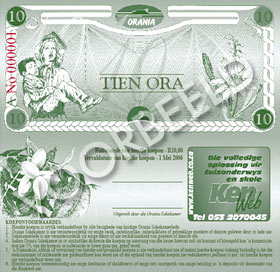Ora (currency)
 From Wikipedia the free encyclopedia
From Wikipedia the free encyclopedia
| Ora | |
|---|---|
 Ten Ora note featuring Racheltjie de Beer | |
| ISO 4217 | |
| Code | None (none is recognized) |
| Unit | |
| Symbol | Φ |
| Demographics | |
| Date of introduction | April 2004 |
| User(s) | Orania |
| Issuance | |
| Central bank | Chamber of Commerce of Orania |
The Ora (symbol:Φ, [ˈʊəra])[1] is the local currency of Orania, an Afrikaner town in South Africa first issued in April 2004. It is pegged at par with the South African rand.[1] The name, recalling that of the town where it circulates, derives from Latin aurum, meaning "gold".[2] The currency is not sanctioned by the South African Reserve Bank.
History[edit]
The idea of the Ora originated in 2002, when Professor Johan van Zyl argued that a community that intended to empower itself should have access to as many instruments as possible, including its own currency.[3] The first notes issued in April 2004 to provide an internal currency for Orania as part of its goal to create an independent Afrikaner state known as a Volkstaat.[citation needed] Before its launch, the South African Reserve Bank cautioned that all items produced could not resemble Rand notes, under South African law.[4]
It is printed in denominations of 10, 20, 50, 100 and 200 Ora. The 10 Ora note depicts Afrikaner history, the 20 Ora notes Afrikaner art; the 50 Ora notes Afrikaner culture; and the 100 Ora note Orania itself.[5] Each note also advertises a local business.[2]
To encourage its use, some stores in Orania offer a 5% discount for items purchased in Ora. The local banking institution, the Orania Spaar- en Kredietkoöperatief, is in charge of the initiative.[citation needed] Rands can be exchanged at this bank for Ora at par. The bank profits from this due to gaining interest on the Rand obtained. The initiative is not supported by the South African Reserve Bank.[6]
The use of the Ora as a payment method also has the effect of discouraging theft, as it can only be used within Orania.[7] About R400,000 to R580,000 worth of Ora were in circulation by 2011.[8] New notes are printed every three years to replace the ones worn out by use.
dOra[edit]

In May 2021, Orania released the first implementation of the so-called dOra.[9] The dOra is a digital copy of the Ora with added benefits, such as electronic payments. The dOra will not replace physical notes, but supplement those that already exist. Additionally, unlike the Ora, the dOra will not have an expiry date. The Orania Technology Group, a local based IT association, lead the development of the digitization of the Ora.
See also[edit]
References[edit]
- ^ a b "Vakansieprogram 2014" (PDF). Orania Beweging. Archived (PDF) from the original on 24 September 2015. Retrieved 12 April 2015.
- ^ a b "Orania cashes in on the 'ora'". News24. 29 April 2004. Archived from the original on 12 February 2017. Retrieved 12 April 2015.
- ^ "Change your rands before trekking to Orania". IOL News. 28 April 2004. Archived from the original on 12 April 2015. Retrieved 12 April 2015.
- ^ "Change your rands before trekking to Orania". Independent Online. 29 April 2004. Retrieved 12 April 2022.
- ^ "'Whites-only' money for SA town". BBC News. 29 April 2004. Archived from the original on 8 January 2015. Retrieved 12 April 2015.
- ^ "Orania wants its own Bitcoin". www.enca.com. Archived from the original on 2017-07-16. Retrieved 2022-04-12.
- ^ "Wo Afrikaaner unter sich bleiben können" (in German). Neue Zürcher Zeitung. 23 January 2009. Retrieved 6 April 2015.
- ^ "Voorgrond" (in Afrikaans). Orania Beweging. July 2011. Archived from the original on 10 April 2015. Retrieved 4 April 2015.
- ^ admin (9 June 2021). "dORA: JOU KAPITAAL IS NOU DIGITAAL". Retrieved 2021-09-14.
External links[edit]
- Mears, Ronald. "The Ora as facilitator of sustainable local economic development in Orania". Archived from the original on 2015-04-16. Retrieved 2015-04-12.